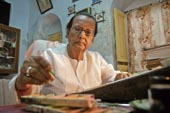 |
| Narayan Debnath at work in his studio. Picture by Bishwarup Dutta; |
 |
 |
 |
| Debnath’s creations: (from top) Handa-Bhonda, Bantul the Great and an illustration for a story |
Handa-Bhonda, Bantul the Great or Nonte Phonte — which Bengali does not know them? These redoubtable comic-strip characters have been popular among readers for half a century. They appeared in the pages of Shuktara and other Bengali magazines — now they have got a lease of life as stand-alone comic books.
The man behind all of them, Narayan Debnath, is now well into his eighties. But the unassuming man keeps himself active in the small studio on the first floor of his ancestral home in Shibpur, Howrah. Age might have slowed him down, but he still draws four comic strips.
His working table is nondescript —- just a board, a few brushes, a bottle of black ink and a few other drawing material. In his customary lungi and kurta, Narayanbabu, a typical Bengali bhadralok, exudes an unusually boyish charm, devoid of the slightest vanity or malice.
He never went out to work and remained a freelancer as an illustrator for the better part of his life. He spends most of the time working in his studio while his three grandchildren keep buzzing about.
Debnath was born in a family of goldsmiths in 1927. He drew from a very early age. It was noticed by his father who decided to send him to art college instead of pushing him into the family business.
He got a job as an illustrator in the late 1940s for Deb Sahitya Kutir, the leading publishing house of Calcutta till the 1960s. “It was thrilling to work with all the great illustrators of those days, Pratul Banerjee, Shailo Chakraborty and Balai Bandhu Roy,” he recalls. He was quite happy with both his work and the payment — Rs 3 for a black-and-white picture — in his early days. But there was much more in store.
During the early 1950s, a request came from the children’s magazine Shuktara, a Deb Sahitya Kutir publication, to start a regular comic strip for its readers. Debnath was baffled. “I was hardly exposed to the world of cartoons and comics, except maybe Tarzan,” he says.
“As a child I used to sit in front of my house in a busy locality and watch people, fooling around. I could get my comic strip from them, I thought,” says Debnath. Thus were born two of the most famous perennial Bengali youths, Handa and Bhonda. “I drew them in the Laurel and Hardy mode, the fat one named Bhonda, was cool and cautious, while his counterpart was Handa, a bit too smart and pompous, who was always getting into trouble.” Handa-Bhonda was launched as a two-page comic strip in Shuktara in the early 1950s.
Its huge success inspired Debnath to start a series with two young girls, called Shutki-Mutki (skinny and fatty). But alas! Two naughty girls didn’t appeal to the Bengali reader — maybe he wanted them just pretty!
Shuktara had now realised the potential of Debnath’s funny characters. He was once again asked to create a new strip with a difference. The editor wanted this to be printed in colour. This was how Bantul the Great, the greatest Bengali comic character, was born. He is a hulk of man, with a bulging chest and muscular arms that makes him look invincible, but disproportionately narrow in his legs and with the face of a boy. He is a hero. There are many attempts to humiliate him — but he always survives with his dignity intact.
“Bantul was first published around 1965, immediately after which India went to war with Pakistan. The editor of Shuktara wanted Bantul to go and fight the enemies,” says Debnath. So Bantul was shown lifting a tank, circling it above his head and throwing it back to the enemies or changing the direction of a cannon shell by simply blowing through his mouth.
Bantul clicked even from the initial stage mainly due to this war series, insists Debnath. The success brought him offers from another children’s magazine, Kishore Bharati, for which he created Patalchand the Magician, which did not enjoy the popularity of Handa Bhonda or Bantul. “In 1969, I started Nonte-Phonte,” says Debnath. That strip became very successful.
The popularity of his comic strips, however, eclipsed the illustrator in him. In the 1970s, he was so occupied with the strips that he hardly had any time for illustration. Deb Sahitya Kutir’s was also on the decline. His illustrations show his ability to create strong and imaginative visuals with an eye on meticulous detailing. Some of his most memorable works were for adventure books like Bane Jangale and Bagh Bhalukker Deshe or the Tarzan series in Shuktara.
And there is also a long list of cartoon strips that didn’t take off — like Shutki-Mutki, Bahadur Beral or Danpite Khadu O Tar Chemical Dadu, but Narayanbabu doesn’t mind anything. He just loves drawing. He doesn’t even mind the artists who copy him blatantly.
No — but there is something that he minds. The animated series of Nonte- Phonte on television.
(The writer is an illustrator with ABP Pvt Ltd, publishers of The Telegraph)










